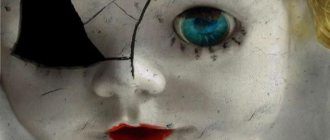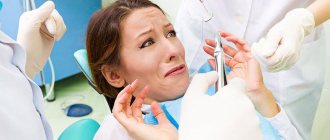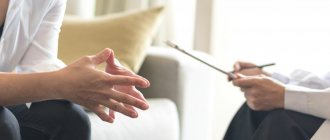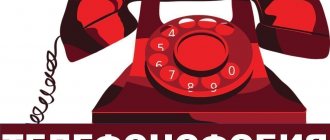How does trypanophobia manifest?
A person suffering from trypanophobia experiences a strong fear of any medical procedure associated with the need for injections or laboratory blood tests. The person does not consent to the injection of drugs and refuses to seek medical help.
Experts identify four main forms of the disorder, each of which has its own symptoms:
- vasovagal;
- associative;
- resistive;
- hyperalgesic.
Signs and symptoms of fear of needles
Trypanophobes try with all their might to avoid meeting the object of fear. They put off visiting a doctor until the last minute, even if their life is in danger. Trypanophobes refuse to watch TV. Even conversations about injections and vaccinations scare them.
If it is not possible to avoid contact, then a number of somatic reactions occur:
- nausea,
- vomit,
- headache,
- dizziness,
- sweating,
- tachycardia,
- arrhythmia,
- chills,
- tremor,
- confusion,
- presyncope and fainting.
A trypanophobe may have a panic attack. At such moments a person does not control himself at all. He can attack a medical worker, run away from the office, scream, and start destroying everything he sees in his path.
How does the associative form of trypanophobia manifest itself?
Associative form (occurs as a result of intimidation of parents, demonstration by parents or other people of fear of injections, as well as due to childhood memories that it was once very scary or painful after an injection).
“All evil comes from the Internet.” The most unusual phobias of the 21st century Read more
In the associative form, the following symptoms occur:
- insomnia;
- panic attacks;
- prolonged background anxiety and concern about the upcoming procedure.
Why is fear of needles dangerous?
Without correction, the trypanophobe’s condition will constantly worsen. Fear of injections provokes the development of the following complications:
- nightmares, frequent awakenings and difficulty falling asleep;
- irritability;
- weakening of concentration and memory;
- emotional jumps;
- obsessive thoughts (negative scenarios with situations where there are injections);
- inability to think about anything else.
Trypanophobe finds himself hostage to his fear. Fear of injections is debilitating, interferes with work and threatens not only a person’s mental, but also somatic health.
Where does the fear of vaccines/injections come from?
Each form of psychological disorder has its own causes.
The vasovagal form is genetically determined and inherited. 80% of people with this form of trypanophobia have close relatives suffering from this disorder. There is a hypothesis that people have developed the ability to faint at the sight of arrows, knives, spearheads, as well as blood (usually someone else's). Losing consciousness and lying motionless on the battlefield helped to survive when meeting the enemy, and the genes of those who survived battles were passed on to their offspring in this way.
The resistant form is associated not so much with the fear of an injection, but with the fear of being helpless and immobilized during the process of medical intervention. The disorder develops against the background of one’s own (usually childhood) negative experience of injections. From childhood, a person can remember how they roughly held his arms and legs, covered his mouth, etc. The stress he experienced at one time leads to the emergence of a panicky fear of an injection.
The associative form of the disorder can arise as a result of a traumatic experience, for example, a child saw a sick relative get an injection, and after some time this person died. The traumatic event causes the patient to associate all needle procedures with the initial negative experience.
The hyperalgesic form is associated with an excessively low pain threshold. A person may actually experience severe pain from the injection. This form of the disease is quite rare (less than 10% of all cases).
“He wants to kill me!” Why are some people afraid of clowns Read more
What is a phobia?
It is common for every person to experience fear - this is a normal reaction, it helps self-preservation. However, a phobia is already a pathology, since it represents a strong fear of imaginary dangers that may not exist at all. There is a big difference between the fear of flying on an airplane and, for example, the fear of appearing on the street among people. If it is not difficult to deal with the first option, then in the second case there is a serious problem that can seriously affect life.
Fear associated with fears of injections and needles is called trypanophobia. This fear of needles and injections has been known since the times of the USSR: at that time, every 5 people were afraid of injections and suffered from similar phobias. However, at that time such fear was well founded, since there were no disposable needles; reusable ones were used. Naturally, during the process of use and sterilization, the needle became dull and could cause quite severe pain to the patient.
In medicine, various types of injections are used - subcutaneous, intramuscular, intravenous. Usually serious treatment is impossible without them.
Trypanophobia is believed to have 4 causes:
- Improper administration of injections by health care workers. Our medicine leaves much to be desired in terms of quality and service. Low salaries of medical workers and a large flow of patients negatively affect the quality of manipulations, and quite often they are performed with negligence.
- Intimidation, stories of unpleasant sensations. Such problems are associated with childhood, when mom or dad scared the child with stories about an evil aunt who would come and give an injection. It is better for mom and dad to avoid such stories for the child.
- Genetics. People are subconsciously afraid of snake or insect bites. There is an opinion that we inherited the fear of needles from our distant ancestors: they needed such a reflex to survive.
- Many people cannot stand the sight of blood. Injections always involve damage to the skin, and blood often appears during injections.
In modern medicine, the use of disposable needles is the norm; such needles cause minimal pain and minimize discomfort.
However, there are several concerns that patients have:
- Fear of contracting AIDS, hepatitis and other serious diseases from injections. This fear becomes the cause of new phobias. In addition, television and the press actively spread rumors about the terrible unsanitary conditions prevailing in medical institutions, which is not always true.
- A person is afraid of an air bubble entering the circulatory system. An experienced medical professional will not allow this to happen. In addition, the rumor that an air bubble in a vein can cause serious consequences is fictitious.
- Fear of skin piercing and the pain that occurs.
- Fear of a bruise appearing at the injection site. With inept manipulation, this can actually happen.
- Fear that the needle will get into the bone or break. If you use a syringe with a quality needle and the correct procedure, this will never happen.
How can you overcome trypanophobia?
Anyone who can analyze their emotions can help themselves. The human body is programmed to independently solve internal problems. Self-help can be expressed in not watching how the nurse draws the medicine into the syringe, turning away at the moment of the injection, distracting yourself with music. You can also try to move the pain center, for example, pinching yourself. In the hyperalgesic form, pain and discomfort can be eliminated with the help of local anesthetics - agents applied to the skin.
Ways to combat trypanophobia
Independent actions for fear of injections
- Distraction
. Some patients consider nurses to be sadists because, in their opinion, they spend a long time and demonstratively preparing for manipulation in the form of an injection into a person’s vein or muscle tissue. However, it is worth remembering the fact that the healthcare worker is simply doing his job, competently preparing everything for the injection. It is necessary not to closely observe the actions of the nurse, but to try to focus on another subject. The same numerous leaflets on the walls of the office for drawing blood and other manipulations sometimes make you forget about the upcoming frightening puncture of the skin with a syringe. - Moving the pain center
. Individuals who are especially suspicious and frightened before the procedure should focus on another area of their body that will experience discomfort. You can pinch yourself, after which the skin puncture itself will not seem such a terrifying action. - Lying position for injections
. In this position of the body, the process of piercing the body with a needle takes place with the least painful effect. If a person wants to reduce his suffering during the procedure described, then it is better for him to be in the position described above. - Complete relaxation
. In some cases, it is easier to give advice than to implement what is recommended in practice. However, with muscle tension, the discomfort during the injection increases significantly. You shouldn’t harm yourself in this way by turning into a bundle of nerves during the procedure. - Positive method
. There is no need to dwell on the problem of how to overcome the fear of injections, because it can be eliminated with the help of humor and a smile. Before a procedure that is troubling and alarming, you need to talk to the medical staff. You need to tell them briefly and clearly about your fears in order to establish contact with the person who will give the injection. - Receiving rewards
. Pampering yourself and your loved one after undergoing the procedure is a great way to relax after experiencing unpleasant moments. You should determine in advance a pleasant thing for yourself, the purchase of which will be carried out after the injection.
Psychotherapy in the fight against trypanophobia
- Autotraining
. Treatment of trypanophobia very often needs to be done using the most radical methods. Before this, you can watch an episode from the movie “Three in a Boat, Not Counting the Dog,” where the most terrible diagnoses were identified from each other using the method of collective analysis. After this, the specialist will teach trypanophobes not to stress themselves out before the necessary skin puncture through special auto-training. - Taking a pain reliever
. Some people have such a high sensitivity threshold that they may lose consciousness when blood is drawn or an injection is made in the buttock. In this case, before going to the clinic, you need to discuss with your psychotherapist possible methods of local anesthesia. It is strictly forbidden to choose your own medications, so that instead of a painless injection you do not end up in a hospital bed. - Taking sedatives
. It is best to use any sedative before the procedure described, which was prescribed by a psychotherapist after consultation. A competent specialist will definitely recommend that his patient visit an allergist initially, so that after taking a herbal medicine, an undesirable reaction of the body to the drug does not appear. You should also remember the fact that sedatives cause drowsiness and some lethargy in people. Therefore, a visit to a medical facility must be carried out in the company of a relative or friend.
Is it possible to get rid of trypanophobia as an adult?
In a mild form, this disorder can be cured on your own, without resorting to the help of professional psychologists or using antidepressants.
Drug treatment of trypanophobia comes down to taking mild sedatives and herbal remedies.
If the disorder is severe, when reactions such as panic attacks, hysterics, etc. appear, you can cope with fear under the guidance of a psychologist. The specialist will analyze the methods of self-regulation that have already been mastered, and will also suggest rational reactions.
Relaxing massage, yoga, martial arts, etc. can also help get rid of trypanophobia.
Key scares
It is common for every person to be wary of objects that can cause pain. Psychologists examined phobia-dependent people and identified the main cases that cause anxiety in patients.
Taking into account the data obtained, the following types of fear were identified:
- The presence of air bubbles in the syringe, which, if they enter a vein, can lead to significant complications and even death.
- The moment of performing the injection is scary because the needle can be dull and it will hurt during the manipulation.
- Failure to maintain sterility can cause an inflammatory process, which in turn will develop into an abscess and require surgical intervention.
- Insertion of a needle may result in the appearance of a bruise, bump, or hematoma at the injection site.
- When performing an injection, you can become infected with tuberculosis or AIDS.
- Injections provoke cancer.
- The needle may break and remain in the body.
These myths can cause significant harm to health, since quite often during blood poisoning or a heart attack it is simply impossible to do without IVs or injections. All the fears of people who suffer from a fear of needles and injections are due to a normal reluctance to feel pain, but most often this does not make common sense.
Treatment options
Eliminating the fear of injections on your own is problematic. Only a positive attitude will help. It is done with the help of affirmations. These are positive statements that work through the technique of self-hypnosis. They need to be repeated before going to the doctor or visiting him.
List of effective affirmations:
- I'm not scared;
- I will endure everything;
- the injection lasts a couple of seconds, so I can withstand it;
- I am strong and courageous;
- I am not afraid of anything;
- it does not hurt;
- everything will go fine, etc.
Breathing techniques are used: deep inhalation lasts 4-5 s, exhalation is slow, carried out through the mouth, duration 3-4 s, average interval between breathing 2-4 s, optimal number of repetitions 5-7 times.
There are 2 effective techniques. One involves only the chest, through which breathing occurs. The other is based on the interaction of the chest, abdomen and collarbones. This type of breathing is called wave-like breathing. Inhalation is carried out in the following sequence: stomach, chest, collarbones. Exhale in the opposite order.
If these methods do not work, you should consult a psychologist. Cognitive behavioral therapy is usually used in the treatment process. During the classes, they discuss why a person is afraid of injections and syringes, what negative emotions are associated with, and why he cannot overcome himself.
The doctor helps to understand the causes of fear.
The task of a psychologist is to change negative attitudes to positive ones. After the sessions, the patient will perceive the needle and syringe not as objects of fear, but as medical equipment.
Treatment with cognitive behavioral therapy consists not only of individual sessions, but also of homework:
- studying the revolution of medical science;
- familiarization with the types of syringes and needles;
- watching videos of people being given injections;
- studying methods of disinfection of working tools, etc.
The patient must understand that giving injections is not dangerous now. The duration of the injection is several seconds.
To get rid of fear, you should thoroughly study the methods of injections
Prevention
When trying to get rid of fear, obsessive thoughts and a panic attack, you need to take some actions. They will also be effective if trypanophobia has just begun to develop.
List of preventive measures:
- Monitor the actions of doctors. Check whether the nurse washed her hands and put on gloves. Be sure to make sure that the syringe is packaged and opened in front of you. If any of the procedures were violated, a remark can be made.
- Don't watch the process. If the process of piercing the skin with a needle scares you or you are afraid of blood, it is better to turn away. At this moment, do not close your eyes, but try to imagine something good.
- Ask for the injection while lying down. This will reduce your chances of fainting. Many people with a fear of injections and needles claim that in this position the pain is less noticeable.
- Take a break. Talk to your doctor. The main thing is not to concentrate attention on the object of fear.
You can use another method: transfer the pain to another part of the body. Pinch yourself, just lightly. This will allow you to forget about inserting the needle into the skin for a few seconds.
If you have a phobia, you should not watch the skin being pierced.
How to overcome the fear of pain: autogenic training method
The autogenic self-training method is one of the most effective ways to combat pain phobia. Every person can learn this technique and successfully apply it in practice in the fight against their own fear. Self-hypnosis has a powerful effect on all processes, both physiologically and psychologically. It affects processes that cannot be regulated consciously - digestion, blood pressure, the functioning of internal organs, and so on.
A set of simple exercises performed in a state of absolute muscle relaxation helps regulate the psycho-emotional state, helps reduce anxiety, and let go of fears and concerns. The overall physical condition improves, the ability to actively work and live a full, joyful life, and actively participate in it is improved.
Autogenic training techniques
Autogenic training is carried out three times a day, namely:
- Right after you wake up.
- During lunch break.
- Before bedtime.
You should spend at least 10 minutes performing the techniques each time. The training is conducted in a secluded, cozy room, completely alone. Extraneous irritants should not distract you. Take a position lying on your back, arms lying freely on the floor, half bent, close your eyes. Focus on the feeling of warmth inside, let yourself feel the heaviness of your own body.
Below is a list of affirmations that you need to say out loud or consciously say in your thoughts. While speaking, try to concentrate your imagination on what you are talking about.
- I am completely relaxed and calm.
- All my facial muscles relax and fill with warmth. Every fold and wrinkle is smoothed out.
- My hands are relaxed and pliable, my muscles are filled with pleasant warmth.
- Every muscle in my legs relaxes, filling with warmth and becoming heavier.
- My entire chest and stomach are filled with a pleasant, warming warmth.
- The rhythm of my heart is measured and calm.
- Blood flows through my vessels, giving me life every minute, feeding my every cell, every vessel.
- I feel lightness, light and clarity in my head.
- My body and nervous system rest, relax, and are filled with peace.
- My nervous system is resilient and strong.
- The nerve cells of the brain are filled with energy and perform their function perfectly.
- I can easily get out of any difficult situation.
- My capabilities are not limited, my strength is enough to achieve any of my goals.
- I feel great.
- I am full of vigor and energy for new achievements.
After saying these affirmations, slowly and smoothly take a sitting position and breathe slowly and deeply for several minutes. Feel how every cell of your body is filled with oxygen. The last affirmation before falling asleep should be: “I am absolutely calm and peaceful. My sleep will be sound and sweet.”
These affirmations help you relax and relieve anxiety. Several months of obligatory repetition every day, three times a day, will give good results. Anxiety will decrease significantly, or disappear altogether.
Why are people afraid of injections?
Few patients want to experience pain during treatment. But they realize that they must endure the injections for the sake of recovery. Injection phobia develops for several reasons:
- incompetent and impolite communication of medical staff when performing manipulations;
- intimidation of a child by adults - in order for him to behave well, many adults threaten to use a needle and syringe to stimulate obedience;
- complications after medical manipulation;
- psychotraumatic situations in childhood associated with injections, these can be completely different moments when the child’s emotional sphere remains vulnerable, trust in the world is shaken and a feeling of danger arises.
Types of fears
Fear of injections is a differentiated fear. People are afraid of different things, and those that can cause pain, especially. Therefore, experts distinguish several types of trypanophobia:
- Fear of needles. Occurs more often in young children. They are afraid not of the process itself, but of the object with the help of which it will occur. Some syringes have thin needles. In most cases they are intended for mantoux or other vaccinations. But there are quite large needles. The child begins to fear that a sharp object will remain inside the skin or harm him in some other way. Therefore, at the sight of a needle, hysteria begins.
- The moment of piercing the skin with a needle. It is not the syringe that frightens a person or a child, but the pain that he experiences from piercing the skin. It seems that the needle will be dull and will take a very long time to enter. This is due to the production of low-quality disposable needles. But private clinics usually take a responsible approach to purchasing medical instruments and choose needles made of special, “medical” steel.
- Penetration of air bubbles under the skin. Fear arises when an injection is administered by a novice, inexperienced specialist. There is a worry that he will not get rid of the air. The patient is worried that the bubbles will penetrate the vein and stop blood circulation. And this will lead to death.
- Fear that a bruise will appear at the puncture site. This really happens if the injection is administered by an incompetent doctor or intern. He can pierce the skin several times until he finds the “right” place. But even after this, it happens that the choice was made unsuccessfully, and the blood vessels were damaged. Then a lump forms. Another reason is an allergic reaction to the solution that is injected into the skin.
Another type is the fear of needle breakage, in which one of the parts will remain in the skin or muscle and damage the bone. Know that if the injection is performed correctly, then this is impossible. The needle only pierces the top layer of skin (epidermis) and cannot reach the bone.
How to give an injection in the buttock correctly
Giving an intramuscular injection is not difficult; mastering such a skill is very useful when the need arises to give an injection to yourself, your precious child, adult relatives, co-workers, etc.
The main thing is to inject carefully, putting aside excitement and nervousness, and be careful
- injections into the muscle promote rapid absorption of the drug, and accordingly it begins to act faster. Due to the high concentration of blood vessels in the muscle tissue, the drug quickly penetrates the blood, mixes with its components, and is transported to its destination;
- In addition to the gluteal muscle, an intramuscular injection can be given in the arm or thigh, but in the latter two cases it is quite difficult to do everything correctly, and there is a risk of damage to nerves and bones. Therefore, without medical education, we recommend not to take risks, but to limit yourself to the “loin part”.











